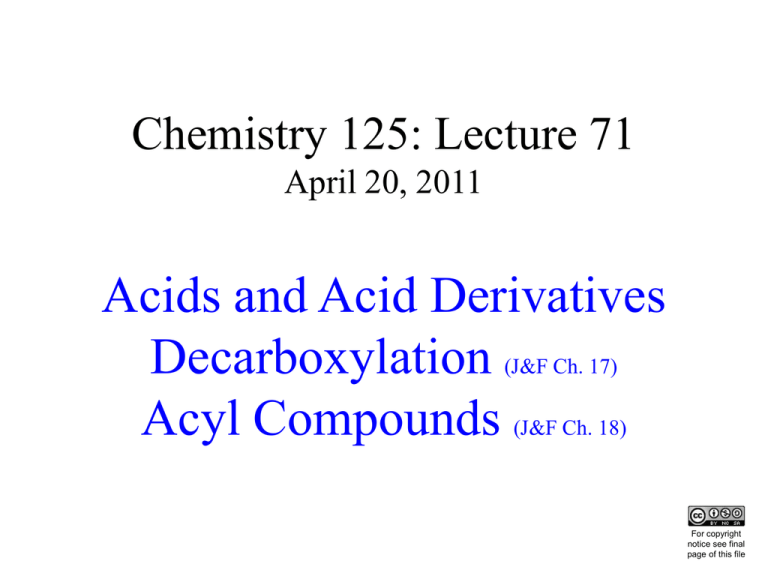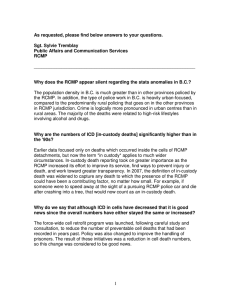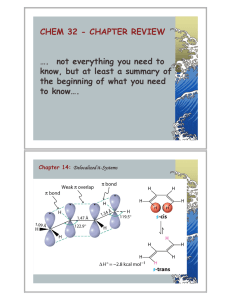
Chemistry 125: Lecture 71
April 20, 2011
Acids and Acid Derivatives
Decarboxylation (J&F Ch. 17)
Acyl Compounds (J&F Ch. 18)
This
For copyright
notice see final
page of this file
R-Li & LiAlH4
(e.g. J&F Sec. 17.7f)
stop at C=O?
LiAlH4
OH
H+
OAlH3
R C H
R C H
H
H
Decarboxylation
(e.g. J&F 17.7g)
malonic acid acid
HO
O
-CO2
C O
H
2
enol
C OH
O
OH
(concerted)
Decarboxylation
(e.g. J&F 17.7g)
or CO2 as leaving group from XCO2- or RCO2•
(e.g. J&F pp. 859-861)
NH3 +
H2O +
carbonic
acid
carbamic
acid
Kolbe Electrolysis
-e-
fast at
4K !
R
R
R = CH3
R=
(Kolbe 1848)
R-R
(~50% 1973)
Decarboxylation
(e.g. J&F 17.7g)
or CO2 as leaving group from XCO2- or RCO2•
(e.g. J&F pp. 859-861)
RCO2H
Ag2O
Br2
RCO2Ag
R-Br
Br2
RBr
R
+ AgBr + CO2
“Hunsdiecker Reaction”
Patents 1936-44
CO2
Decarboxylation
(e.g. J&F 17.7g)
or CO2 as leaving group from XCO2- or RCO2•
(e.g. J&F pp. 859-861)
O=C=O
RCO2 MgBr
R-MgBr
Ag2O
RCO2Ag
+
? Mg
+ AgBr + CO2
“Hunsdiecker Reaction”
Patents 1936-44
H+
Alexander Porfiryevich
Br2
RBr
“R-”
KCN
“R+”
H2O
RC Borodin
N H or HO RCO2H
-
+
D
1833-1887
Published
in 1861
Tony
award 1954
(Kismet)
A. Sdobnikov
RCO2H
Acid Derivatives
(e.g. J&F Ch. 18)
+3
+3
O
-2
R C
R CN
nitrile
H2O
+3
R-CO2H
+2
H2C=C=O
X:
ketene
H2O
-3
+3
H3C-CO2H
CH3-C=O(X)
strong & independent
Spectroscopy
(pp. 888-889)
C=O strengthened
by resonance
CH3C
O+:
Cl
1746
CH3C
1727
+
O:
-OCH
O
nO *C-Cl nO *C-OMe
O
H
1681
CH3C
CH3C
CH3C
3
1715
O+
:
1806
C=O weakened
by resonance
CH3
NH2
nN *C=O
% Transmission
%T
acyclic anhydride
out
in of
phase
phase
cyclic imide
out
in phase
of phase
Interconversion of Acid Derivatives
(e.g. J&F pp. 886, 890, Figs. 18.17,18.22)
Leaving Group
Hierarchy
pKa
Cl-H -8
-
O
R C
X
Y
SOCl2
- ~5
R’CO2H
RCO2H2O R’O-H transesterification
~16
Tetrahedral Intermediate
acid-catalyzed
(A/Dorsubstitution,
rather than
(as in Fischer
esterification)
pentavalent
transition
state as in SN2)
R’2N-H
K ~1
(shift by law of
~35
mass action)
differences reinforced by
resonance stabilization:
O-
O
R
R
C
Y:
C
Y+
Saponification K>>1
“I ain’t afraid to wash
my hair in it.”
“That there lard
eats the lye.”
RCO2
triglyceride
- (fat) RCO2
RCO2
O
R C
OR
HO pK K~5~10
HOR pK ~16
Lye KOH
HO- RO-
a
a
11
RCO2K
HO
RCO2K
HO
RCO2K
HO
soap
glycerine
Going All the Way to C-OH
(e.g. J&F pp. 891, 898-9, 903 (C-NH2))
Stopping Part Way
to Preserve C=O
(e.g. J&F pp. 892-893 (Fig. 18.22); 900 (Fig 18.38))
Acidic / Basic Hydrolysis of RCN
pp. 904-905
O
C-OH
Acidic
Hydrolysis
of RCN
Basic Hydrolysis of RCN
Acyl Compounds from Ketene
(J&F Sec. 18.11, p. 907)
pKa = ~35
O
(Nu = N)
HNu
H2C=C=O
Nu:
Nu
or H+
catalyzed
R3N
H2C=C=O
HCH2 C
pKa = 17
H-OC(CH3)3
H+
H-SEt
87%
pKa = ~10
93%
-80°, 3 days
pKa = ~31
H
Ph-N-CH3
EtOH / H2O
75%
Insertion into Acyl-R Bond
Munich
1896
Victor Villiger
Adolf v. Baeyer
Baeyer-Villiger Reaction - 1900
(insert O)
(e.g. J&F pp. 907-909)
End of Lecture 71
April 20, 2011
Copyright © J. M. McBride 2011. Some rights reserved. Except for cited third-party materials, and those used by visiting
speakers, all content is licensed under a Creative Commons License (Attribution-NonCommercial-ShareAlike 3.0).
Use of this content constitutes your acceptance of the noted license and the terms and conditions of use.
Materials from Wikimedia Commons are denoted by the symbol
.
Third party materials may be subject to additional intellectual property notices, information, or restrictions.
The following attribution may be used when reusing material that is not identified as third-party content:
J. M. McBride, Chem 125. License: Creative Commons BY-NC-SA 3.0












